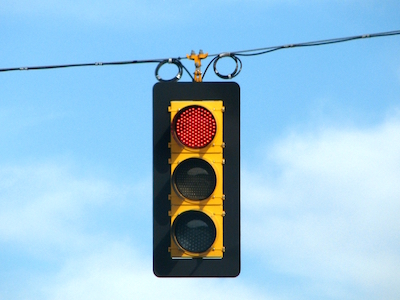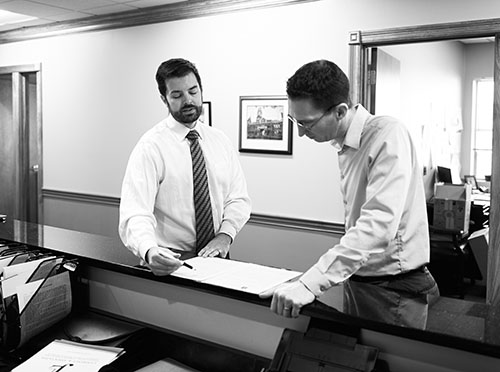The Dayton, Ohio Red-Light Camera Dispute – What do I Need to Know?
Posted on Tuesday, February 21st, 2017 at 11:21 am
The following post is part of our Law Student Blog Writing Project, and is authored by Caitlin DiCrease, a law student from Ohio State University Moritz College of Law.
What is the law on Red-Light Cameras in Ohio?
 Speeding and the running of red lights are two of the most common traffic violations across the United States. In order to combat these problems, many cities installed cameras on roadways and in intersections that would take photos or videos of vehicles committing traffic violations. Law enforcement would review the tapes and ticket the vehicles that were recorded doing something illegal, such as moving above the posted speed limit or running a stop-light. The tickets would then be mailed to the individual listed on the vehicle’s registration. These cameras have been challenged in several states – people believe they are inaccurate, not cost-effective, are intended only to catch more speeders and increase police revenues from tickets, and that they could even infringe upon constitutional rights. Those who favor the cameras say that they free up police officers’ time, so that they no longer need to spend as much time catching traffic violators and can focus on more serious crimes.
Speeding and the running of red lights are two of the most common traffic violations across the United States. In order to combat these problems, many cities installed cameras on roadways and in intersections that would take photos or videos of vehicles committing traffic violations. Law enforcement would review the tapes and ticket the vehicles that were recorded doing something illegal, such as moving above the posted speed limit or running a stop-light. The tickets would then be mailed to the individual listed on the vehicle’s registration. These cameras have been challenged in several states – people believe they are inaccurate, not cost-effective, are intended only to catch more speeders and increase police revenues from tickets, and that they could even infringe upon constitutional rights. Those who favor the cameras say that they free up police officers’ time, so that they no longer need to spend as much time catching traffic violators and can focus on more serious crimes.
Red-light cameras, those posted at intersections to catch drivers who run red-lights, are currently permitted in twenty-one states. Ohio cities, including Dayton, had been using red-light cameras in the early 2000s to ticket drivers who committed traffic violations. People who had been ticked by the use of the red-light cameras brought lawsuits, claiming that the use of red-light cameras was unlawful. In 2008, the Ohio Supreme Court ruled that traffic camera use is legal, citing the “home-rule” authority of Ohio municipalities. Home-rule authority is the right of a local government to regulate actions within its boundaries in order to protect the public. This protection includes police activities, such as preventing car accidents by enforcing traffic laws and speed limits. As a result of this case, cities were told that they were permitted to install traffic cameras if they chose to do so. The court again ruled that the use of traffic cameras was legal in 2015.
However, in 2014, the Ohio General Assembly passed Senate Bill 342, which created new regulations for the use of traffic cameras across the state of Ohio. The regulation at the heart of the red-light camera issue is the requirement that a full-time police officer must be present where the traffic cameras are operating. In order to obey the new law, cities would have to station a police officer at each intersection where a red-light camera was being used. This would be very costly for cities and would make the red-light cameras much less valuable to law enforcement. As a result, many cities stopped their red-light camera programs. The 2014 law carries additional costly requirements, such as a lengthy study of traffic conditions at each site where a camera is to be installed prior to installation of the traffic camera.
What Happened in Dayton?
Dayton, Ohio had begun installing and using red-light cameras in 2002. There are more than three dozen traffic cameras in Dayton, which were used to catch both red-light and speed violations. When the Ohio General Assembly passed its 2014 law limiting the use of red-light cameras and requiring a police officer be present when the camera is in use, the city of Dayton filed a lawsuit against the state of Ohio.
Dayton argues that the law is unconstitutional because it violates the city’s home-rule authority. Dayton also argues that the 2014 law was created to impose impossibly harsh burdens on states that wanted to use traffic cameras so that the cities would stop using the cameras. The attorneys for the city believe that this law is an illegal use of the state’s power to regulate the city’s ability to control local policing and regulation of traffic laws. They also claim that the cost of completing traffic studies and paying police to physically monitor the areas where cameras are installed is too high, and defeats the purpose of the cameras. The city says that the 2014 law creates an effective ban on traffic cameras by making their use far too costly to be productive.
Meanwhile, the state of Ohio argues that the 2014 law was intended to create a uniform framework for automated traffic camera use across the state. The lawyers for Ohio claim that the Ohio Constitution only grants limited policing powers to cities under their home-rule authority, and that a uniform law governing the use of traffic cameras is beneficial to Ohio citizens. They say it would be confusing for drivers to have different traffic regulations in each city that they drive through. The state argues that, much like a city would be unable to use blue stop signs, it should not be able to use traffic cameras in a way that is different from other areas of the state.
The case is currently being considered by the Ohio Supreme Court. The court will rule on the Dayton case, as well as similar cases involving traffic cameras in the cities of Springfield and Toledo.
What will the Ohio Supreme Court do?
Hopefully, the court will rule on the whether or not the 2014 law is constitutional so that cities across the state know the standard requirements for traffic camera usage. While it is impossible to know exactly how the court will rule on the Dayton case, the Ohio Supreme Court has issued earlier rulings in 2008 and 2015 stating that the use of traffic cameras in Ohio is legal. It is possible that the court will find the 2014 law to be an unconstitutional infringement on a city’s home-rule authority and ability to implement programs for the safety of the public. However, the state’s arguments in favor of a statewide, uniform regulation for the use of traffic cameras may be convincing enough for the court to rule in favor of the city of Dayton.
Oral arguments in Dayton v. State were heard by the justices of the Ohio Supreme Court on January 10, 2017. The justices will take time to consider their decision and issue a ruling. Typically, the Ohio Supreme Court takes four to six months to release decisions, so a ruling on the Dayton red-light camera issue is likely to be published between May and July of 2017.
What do I Need to Know About Red-Light Camera Use in Ohio?
Currently, most cities in Ohio are not using red-light cameras because of the cost of having a police officer present at the camera locations while the cameras are in use. This means that you are unlikely to be ticketed by a traffic camera in the state of Ohio, however, there are some areas that are still using select red-light cameras. If you were recently ticketed by a red-light camera, a police officer was required to be physically present in the immediate area for the ticket to be valid. If the city has not complied with the 2014 requirements, you can challenge your ticket successfully.
However, if the Ohio Supreme Court strikes down the requirements, cities will again use traffic cameras to ticket people for speeding and running stop-lights. At that point, cities will likely add more traffic cameras to record traffic violations, and if you speed or run a light in view of one of these cameras, you will be ticketed. Drivers should keep an eye out for the court’s decision, and, as always, you should drive carefully and legally for the protection of yourself and those around you.










